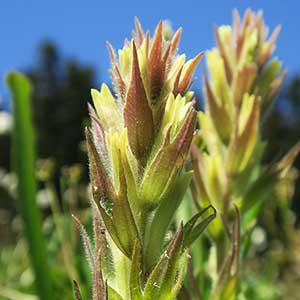Castilleja attenuata
Castilleja cryptantha
attenuate Indian paintbrush, attenuate paintbrush, narrow-leaf owl's-clover, narrow-leaf owl-clover, narrow-leaf paintbrush, valley-tassels
Mt. Rainier or obscure paintbrush, obscure Indian paintbrush, obscure paintbrush
solitary, erect to ascending, unbranched, sometimes branched from base, hairs spreading, short and medium, ± stiff, eglandular.
few to several, erect or ascending, unbranched, hairs spreading, long, soft, eglandular, mixed with short stipitate-glandular ones.
green to purple-tinged, linear to linear-lanceolate, (1–)2–8 cm, not fleshy, margins plane, flat, 0(–5)-lobed, apex acuminate;
lobes spreading to ascending, filiform to lanceolate, apex sometimes acuminate.
green, often with brown or purple veins, narrowly to broadly lanceolate, 1.5–4 cm, not fleshy, margins plane, ± involute, 0–3-lobed, apex acute to acuminate;
lobes spreading-ascending, narrowly lanceolate, apex acute to ± obtuse.
(1.5–)2–10(–19, –30 in fruit) × 1–2 cm;
bracts proximally green to pale brown, rarely dull reddish brown, distally white on apices, sometimes pale yellow or pale pink-purplish on apices, rarely greenish or dull reddish brown throughout, lanceolate or lanceolate-elliptic, 3(–5)-lobed;
lobes ascending, linear to lanceolate, long, arising below mid length, apex acuminate, acute, or obtuse.
(2.5–)3–6 × 1–2 cm; green to dull brown or dull reddish purple throughout, or proximally green to dull brown or dull reddish purple, distally yellow on apices, broadly lanceolate to ovate, (0–)3-lobed;
lobes ascending, narrowly lanceolate, long or short, arising near mid length, apex acute or acuminate.
straight, 10–25 mm;
tube 9–20 mm, not expanded distally;
beak exserted, straight, adaxially white, light yellow, or greenish, 3–5 mm, inconspicuously puberulent;
abaxial lip white or yellow with deep brown to purple spots, often becoming pink, slightly inflated, exserted or not, pouches 3, 2 mm wide, 1–1.5 mm deep, 3–4 mm, 75–80% as long as beak;
teeth erect, white, pale yellow, or pink, 0.5–1.2 mm.
straight, 14–16 mm;
tube 11–14 mm;
whole corolla included within calyx;
beak adaxially pale yellow, 1–2 mm;
abaxial lip deep green, slightly inflated, 4–5 mm, 67% as long as beak;
teeth ascending, pale, 1.5–2 mm.
colored as bracts, (8–)15–23 mm;
abaxial and adaxial clefts (4–)6–8 mm, abaxial ca. 50% of calyx length, adaxial ca. 75% of calyx length, lateral 3–3.5 mm, 33% of calyx length;
lobes linear to narrowly triangular, apex acute to acuminate.
proximally green or pale with green veins, lobes yellow, sometimes becoming deep red with age, 12–15 mm;
abaxial and adaxial clefts 3–7 mm, 25–50% of calyx length, deeper than laterals, lateral 1–3(–4) mm, 8–20% of calyx length;
lobes triangular, adaxial segments longer than abaxials, apex acute or obtuse.
glabrous.
= 24.
= 24.
Castilleja attenuata
Castilleja cryptantha
Castilleja attenuata is a common and widespread species, ranging from southwestern Canada to northern Baja California, with several disjunct populations in central Chile. It is sensitive to competition from weeds. Disjunct populations in the Rincon Mountains in Pima County, Arizona, often have pink bracts but are otherwise typical.
(Discussion copyrighted by Flora of North America; reprinted with permission.)
Castilleja cryptantha is endemic to the vicinity of Mt. Rainier in the Cascade Range, with most populations found within Mt. Rainier National Park. Unlike most species of Castilleja, it is apparently self-pollinating (W. J. Duffield 1972); the small flowers are entirely enclosed within the yellowish calyces, which tend to grow deep reddish as they age. The purplish brown bracts are also unusual in the genus.
(Discussion copyrighted by Flora of North America; reprinted with permission.)
- Local floras:
BC,
CA,
OR,
WA
- Local Web sites:
CalFlora,
CalPhotos,
Flora NW,
PNW Herbaria,
Turner Photog.
WildflowerSearch
iNaturalist (observations)
USDA Plants Database
- LBJ Wildflower Center
- SEINet
- Plants of the World Online
- Encyclopedia of Life
- Wikipedia
- Google Image Search


